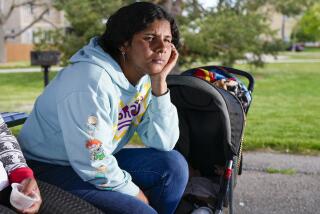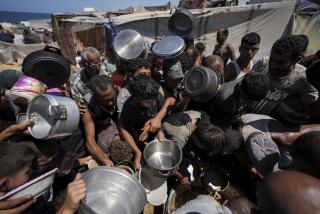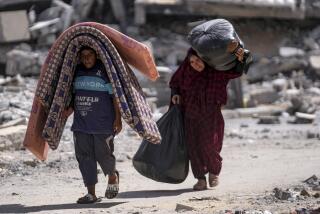For Syria refugees, camp life gets even worse in winter
ZAATARI CAMP, Jordan — Rumors that four infants perished from the cold prompted an outcry last month at this sprawling site, by far the largest camp for Syrian refugees.
Some residents even tossed stones at the military field hospital said to be where the children died, although officials say all four succumbed to medical conditions that had nothing to do with the weather.
“These were incorrect rumors,” said Ahmad Maaytah, a doctor from the hospital, as his colleagues nodded in agreement at a camp clinic.
Still, the incident is indicative of the extraordinary pressure that the winter chill is placing on already thinly stretched international efforts to cope with an influx of more than 700,000 refugees, mostly women and children, in Jordan and other nations bordering Syria. Thousands more arrive each day, many with little more than the clothes on their backs.
They are a social and economic strain on Syria’s neighbors, and they are the most dramatic illustration of how Syria’s 21-month-old war is spilling across its borders.
Winter’s cold is a serious threat, especially for children and those already weakened after their escape from Syria, say officials with the United Nations and other agencies assisting the Syrian multitudes.
Many now arrive drenched and shivering in the rainy evenings, their shoes caked with mud. Inevitably, a number suffer from physical ailments and psychological trauma.
On a recent evening, 22 newborns and an 85-year-old woman accompanied by her grandchildren were among those crossing into Jordan, U.N. officials said.
Two of the recent infant deaths at Zaatari resulted from severe diarrhea, possibly because of poor hygiene, the U.N. refugee agency said. The other two suffered from congenital defects, one of the heart and the other of the digestive tract, according to the U.N.
At Zaatari, home to about 40,000 refugees, workers are hastening to winterize the vast camp, situated in an inhospitable stretch of desert where winter temperatures regularly plunge below freezing and strong winds and snow are not uncommon.
Officials are distributing tens of thousands of “high thermal blankets,” and a Norwegian relief group is providing portable gas heaters. Saudi Arabia and other donors have provided prefabricated fiberglass homes to allow some people to escape the canvas tents where most refugees still live.
Contrary to popular perception, fewer than one quarter of Syrian refugees live in the region’s 20 camps, three each in Jordan and Iraq and 14 in Turkey.
The vast majority of refugees stay with host families, rent homes or otherwise scramble to find housing and aid. More than 500,000 have signed up for U.N. assistance.
The crisis is especially acute for Syrians who have fled to Lebanon, where there are no refugee camps and humanitarian groups are stretched to find host families, public facilities, vacant buildings and other places to house the dispossessed. Refugees are scattered across hundreds of towns and villages, some in isolated corners of the Bekaa Valley and other remote zones, often crammed into substandard and overpriced accommodation.
“There were protests and gunfire; my children were scared, so we had to leave” Syria, said a mother of three huddled in a converted storage space in the Bekaa town of Zahle, where she pays $150 a month, almost three times her former rent in the strife-torn Damascus suburb of Hajar Aswad, which she left three months earlier.
“This is where we shower and do laundry,” said the woman, 30, pointing to a bucket on a concrete slab.
But she may be better off than many other displaced Syrians. An estimated 2 million people who have been forced from their homes but remain in Syria probably suffer the worst deprivation. Some are making do by roughing it in fields, bombed-out buildings and abandoned schools. Many still face danger from bombardment and firefights as they try to cope with a lack of shelter, food, medical care and other necessities.
At Zaatari, as at other camps, life is spartan, and it is not difficult to find people complaining about the conditions.
The other day, a mother scoffed at the quality of the blankets covering her two boys, who were sleeping at noon because it is too cold to doze off in the evening.
“Look!” said the mother, Jamileh, who, like others interviewed, declined to give her full name for security reasons. “How can they be warm with blankets as thick as tissue paper?”
But residents are safe, away from shelling and firefights, and their basic needs are met.
In a few months, Zaatari has seen a dramatic transformation from a tent camp of refugees listlessly wandering in a Martian-like landscape to a bustling mini-city.
The main thoroughfare that runs through the heart of the camp has become an open-air marketplace, with signs boasting of “Syrian quality” produce, bread, clothes, cellphones, perfume and other products.
Boys roam the street hawking cigarettes and phone cards. Satellite dishes poke from scattered cafes set up in tents, where clients can also enjoy the requisite water pipes.
Spirited suppliers risk daily trips into Syria, bringing back a variety of goods, even desserts from venerable sweet shops in the war-torn southern city of Dara. Aid distribution centers have become computerized, five medical clinics are operating, and children attend an on-site school.
Cinder-block structures interspersed among the tents house the bathrooms.
Many single young men, long a source of tension and instability, are now employed as guards or laborers assisting in the camp’s construction requirements, no longer with too much time on their hands. The violent clashes with Jordanian police that marked Zaatari’s turbulent early history appear to have abated.
“Finally, you can at least have some money to spend on yourself,” said Firas, who displayed notes and coins of different currencies, part of the yield from his falafel shop along the camp’s main drag.
But Firas, who arrived at Zaatari with his wife and children, said he plans to return to Syria and rejoin the rebels fighting to oust the government of President Bashar Assad. He didn’t relocate to this patch of desert to make flatbread delights, he said.
“I came for medical treatment,” Firas said, lifting his shirt to expose bullet wounds and scar tissue, injuries he said he sustained while fighting against the Syrian government.
Bulos is a special correspondent. Special correspondent Alexandra Sandels in Zahle contributed to this report.
More to Read
Sign up for Essential California
The most important California stories and recommendations in your inbox every morning.
You may occasionally receive promotional content from the Los Angeles Times.











